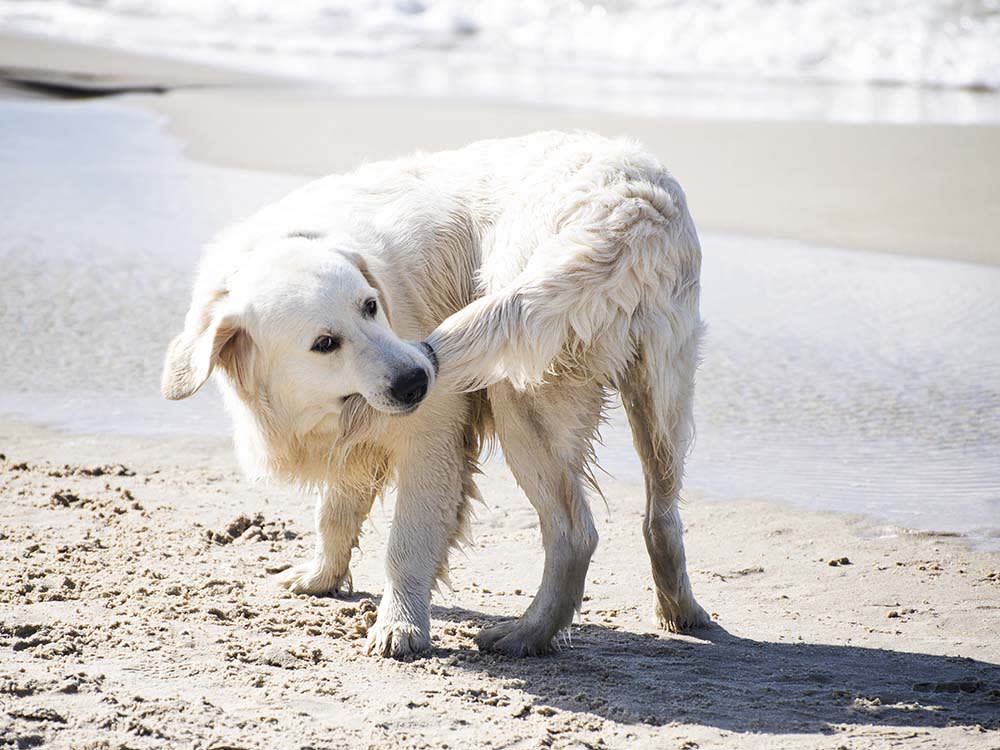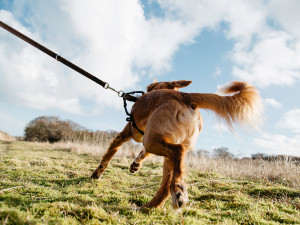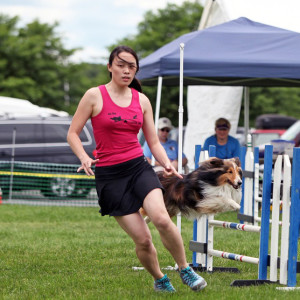Understanding Limber Tail Syndrome: Causes, Symptoms, and Treatment
Seeing your pup’s normally perky tail go limp can be unnerving, but it’s really nothing to panic about.
In This Article:
What Is Limber Tail Syndrome? What Causes Limber Tail Syndrome? Which Dog Breeds Are More Likely to Develop a Limber Tail? How Is Limber Tail Syndrome Diagnosed? How Is Limber Tail Syndrome Treated?
Imagine your surprise when, after a full day of activities, your normally rambunctious dog starts to act strangely. They may sit down slowly and gingerly like a senior pup, rather than flopping down as usual. Or maybe that tail that is typically whacking everything in sight (and letting you know just how excited they are about everything) is oddly still — and hangs limp. Did they break their tail?
You try to recall if your pup did anything unusual during the day but can’t think of anything — not even a yip of pain while they were playing. Now, your dog won’t even let you look back there. What could be causing your dog’s tail to be limp and painful? This is a classic scenario for a strange condition known as limber tail syndrome in dogs.
Snap a pic of your pup’s teeth, and GREENIES™ will help you spot potential signs of oral health issues.
Main takeaways
Limber tail syndrome causes a dog’s tail to suddenly be limp and painful.
This condition does not have a known cause but is associated with certain kinds of activities and certain breeds of dogs.
It is important to seek veterinary attention to get your dog proper pain relief and to be sure there is not a more serious medical problem causing your dog’s pain.
What is limber tail syndrome?
Limber tailopens in new tab is a condition in which dogs suddenly develop a flaccid or limp tail. This problem usually resolves on its own within days to weeks, but it is painful. The scientific name for this syndrome is acute caudal myopathy, which is just a fancy way of saying that there’s a sudden onset of problems with the tail muscles.
How much do you spend on your pet per year?
This syndrome has many other nicknames, including “cold tail,” “limp tail,” “frozen tail,” “swimmer’s tail,” “dead tail,” “rudder tail,” and (adorably) “broken wag.” While this condition is well-known in veterinary medicine, the exact mechanisms that cause it are still unclear.
What causes limber tail syndrome?
We know that limber tail syndrome is associated with certain activities that seem to cause overexertion of the muscles in the tail. Here are some factors that may contribute to it.
Prolonged cage transport: A dog who is transported long distances while in a crate may injure their tail as they try to use it to maintain balance in a restricted area.
Under-conditioning and overexertion: These injuries often follow a day of heavy activity after a longer sedentary period.
Cold, wet weather: The condition seems to occur more frequently in colder climates, though it can still be seen in warm weather, too.
Swimming: There is an increased risk of occurrence after swimming and water activity.
There also seems to be a genetic predisposition to this condition, with dogs who are related often suffering from the condition, and certain breeds having a higher incidence of it as well.
Which dog breeds are more likely to develop a limber tail?
Limber tail syndrome is more likely to show up in athletic, working breeds such as these:
Labrador Retrievers
English Pointers
English Setters
Flat-Coated Retrievers
Beagles
Foxhounds
Dalmatians
Coonhounds
Doberman Pinschers (with undocked tails)
How is limber tail syndrome diagnosed?
Diagnosis is made after your vet collects a thorough history and performs an examination.
Some common symptomsopens in new tab of limber tail in dogs include:
A stiff tail base
A limp tail
Pain when the tail is touched or lifted
Erect hair at the tail base
Pain when sitting
Holding their tail off to one side
A colder temperature around the base of the tail
These signs, in combination with a history of recent activities known to cause limber tail, make the diagnosis highly likely. Your vet will also do additional tests to rule out other conditions that could cause pain and/or paralysis of your dog’s tail.
Researchers have developed some very fancy waysopens in new tab to evaluate limber tail, too. These include MRIs, muscle biopsies, measurement of muscle proteins, nerve stimulation testing, and even thermal imaging. For a routine case of limber tail, however, these tests add unnecessarily invasive procedures and expenses — so they are not usually recommended or necessary.
How is limber tail syndrome treated?
Thankfully, limber tail isn’t a life-threatening condition, and it usually resolves on its own within a few days to weeks. Treatments are aimed at supporting your dog as they heal.
At-home treatments for limber tail syndrome
The best treatment for limber tail is rest, so encourage your dog to take it easy for at least one to two weeks. This means avoiding strenuous activities such as off-leash play, running, swimming, agility movements, and hiking. If your dog can tolerate it, a warm compress applied to the tail can also be helpful.
For many dogs, rest and time is adequate for them to make a full recovery. You may need to get creative to keep your dog entertained while they are on bed rest, crate rest, or couch rest. However, since this condition can be painful and distressing for many dogs, it is a good idea to consult a vet for additional support.
Veterinary treatments for limber tail syndrome
Your vet will do a thorough exam on your dog to rule out other conditions that could cause similar signs, including traumatic injuries (like broken bones in the tail), as well as neurological conditions that could cause paralysis of the tail. Additionally, your vet can prescribe safe, effective pain medications to give your pup relief while their tail is healing. An added benefit is that some pain medications also have mild sedative effects, which will encourage your pup to get the rest they need to heal.
When should I consult a veterinarian?
You should always consult a vet to help diagnose this condition, because not every droopy tail is caused by limber tail. Dogs who have suffered direct trauma to their tails may have similar symptoms. Anal gland issues can also cause dogs to clamp their tail down to guard the area. Getting a painful backside evaluated by a veterinarian can help make sure there’s nothing more serious going on there. This is especially important if your dog acts like they’re in extreme pain, has other signs of illness, and/or their breed and recent history don’t really fit with the profile for limber tail.
Can limber tail syndrome recur?
Limber tail syndrome can recur. A little more than 40 percent of dogs will have a recurrence, with some dogs having multiple recurrences throughout their life. Because most dogs recover quickly, these events usually aren’t too worrisome. However, if your dog is having ongoing episodes of limber tail and it is affecting their quality of life, some lifestyle changes may be needed to avoid the inciting causes.
Can limber tail syndrome be prevented?
Limber tail syndrome is unpredictable, but there are things you can do to help limit your dog’s risk. If you’re taking a long trip with your dog in a crate or kennel, stop every two to four hours to let them out and give them a break — or try using another safe form of restraint, so they don’t have to be crated for long trips. Avoid weekend warrior syndrome, where your pup goes from being a couch potato all week to taking on Olympic-level feats on the weekends. Gradually ramp up activity, especially water activities, giving them time to adjust. Be especially mindful of the weather and limit time outdoors on very cold, damp days.
FAQs
Can I walk my dog with a limber tail?
Yes, you can take your dog on slow, controlled walks while they are healing from limber tail syndrome. They should not be allowed off-leash and walks should be kept short.
Why is my dog’s tail down but acting normal?
There could be multiple causes why a dog’s tail is hanging down, including limber tail syndrome. It is important to have a vet make the diagnosis to rule out other possible causes.
Does limber tail heal on its own?
Yes, limber tail syndrome should resolve within two weeks, even without any treatment. However, this can be a painful condition, and most dogs should be given appropriate pain medications by their vet.
Bottom line
Limber tail syndrome is a tail injury most common in active working dogs that tends to resolve within a few days to weeks.
It is important to seek veterinary care to confirm the diagnosis, rule out other possible causes, and get adequate pain relief for your pup.
References
Abbas, G, et al. “Limber tail syndrome in a German Shepherd dogopens in new tab.” Veterinary Science Development, vol. 5, 2015, pp. 5831.
Gomes, SA, et al. “Magnetic resonance findings of presumed limber tail syndrome (caudal myopathy) in a Dobermannopens in new tab.” Journal of Small Animal Practice, vol. 60, no. 4, April 2019, pp. 261.
Pugh, CA, et al. “Cumulative incidence and risk factors for limber tail in the Dogslife labrador retriever cohortopens in new tab.” Vet record, vol. 179, no. 11, 17 September 2016.












